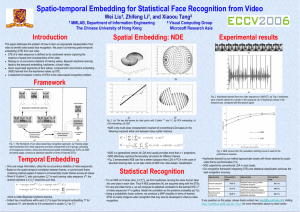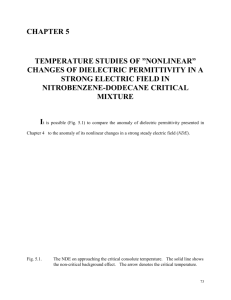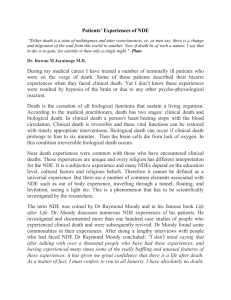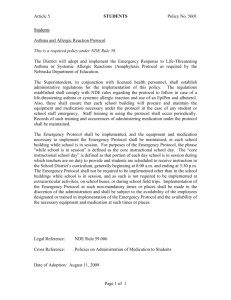Spatio-temporal Embedding for Statistical Face Recognition from Video Wei Liu , Zhifeng Li
advertisement
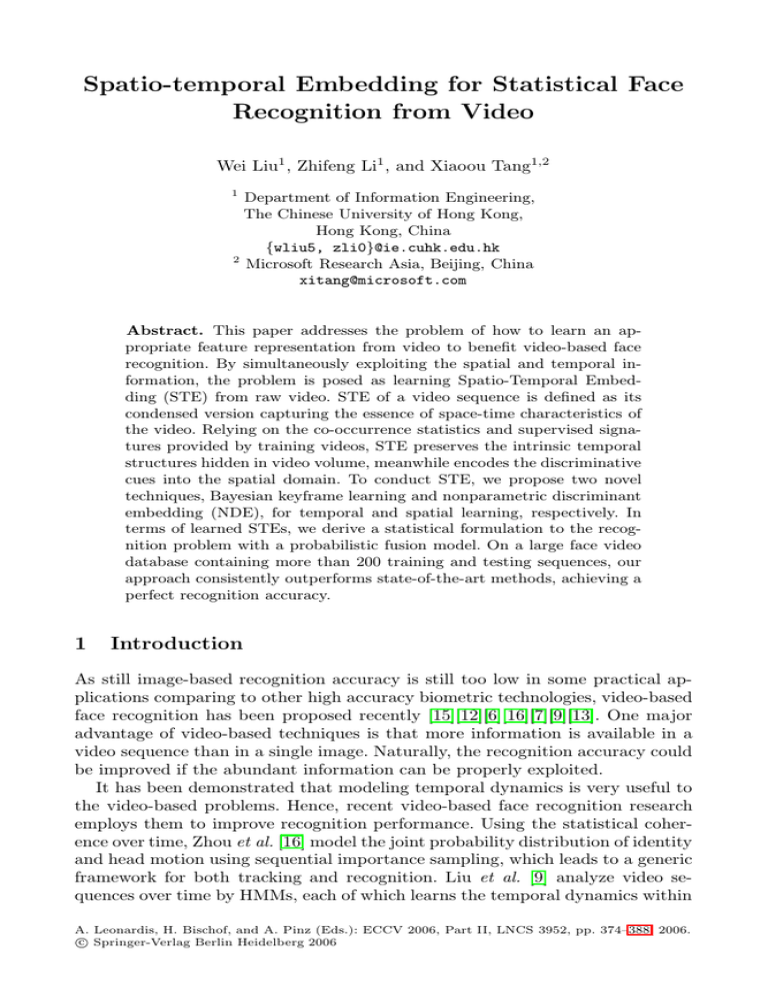
Spatio-temporal Embedding for Statistical Face
Recognition from Video
Wei Liu1 , Zhifeng Li1 , and Xiaoou Tang1,2
1
Department of Information Engineering,
The Chinese University of Hong Kong,
Hong Kong, China
{wliu5, zli0}@ie.cuhk.edu.hk
2
Microsoft Research Asia, Beijing, China
xitang@microsoft.com
Abstract. This paper addresses the problem of how to learn an appropriate feature representation from video to benefit video-based face
recognition. By simultaneously exploiting the spatial and temporal information, the problem is posed as learning Spatio-Temporal Embedding (STE) from raw video. STE of a video sequence is defined as its
condensed version capturing the essence of space-time characteristics of
the video. Relying on the co-occurrence statistics and supervised signatures provided by training videos, STE preserves the intrinsic temporal
structures hidden in video volume, meanwhile encodes the discriminative
cues into the spatial domain. To conduct STE, we propose two novel
techniques, Bayesian keyframe learning and nonparametric discriminant
embedding (NDE), for temporal and spatial learning, respectively. In
terms of learned STEs, we derive a statistical formulation to the recognition problem with a probabilistic fusion model. On a large face video
database containing more than 200 training and testing sequences, our
approach consistently outperforms state-of-the-art methods, achieving a
perfect recognition accuracy.
1
Introduction
As still image-based recognition accuracy is still too low in some practical applications comparing to other high accuracy biometric technologies, video-based
face recognition has been proposed recently [15][12][6][16][7][9][13]. One major
advantage of video-based techniques is that more information is available in a
video sequence than in a single image. Naturally, the recognition accuracy could
be improved if the abundant information can be properly exploited.
It has been demonstrated that modeling temporal dynamics is very useful to
the video-based problems. Hence, recent video-based face recognition research
employs them to improve recognition performance. Using the statistical coherence over time, Zhou et al. [16] model the joint probability distribution of identity
and head motion using sequential importance sampling, which leads to a generic
framework for both tracking and recognition. Liu et al. [9] analyze video sequences over time by HMMs, each of which learns the temporal dynamics within
A. Leonardis, H. Bischof, and A. Pinz (Eds.): ECCV 2006, Part II, LNCS 3952, pp. 374–388, 2006.
c Springer-Verlag Berlin Heidelberg 2006
Spatio-temporal Embedding for Statistical Face Recognition from Video
375
a video sequence. Comparing likelihood scores provided by the HMMs, the identity of a testing video sequence is yielded with the highest score. Because learning
temporal dynamics during the recognition stage is very time-consuming, above
statistical models can not suffice for the real-time requirement of automatic face
recognition systems. Lee et al. [7] approximate a nonlinear appearance manifold
which stands for one subject (person) as a collection of linear submanifolds, and
encode the dynamics between them into the transition probability. The manifold
learning algorithms in [7] are subject-specific and lack the discriminating power,
so they do not adapt well to the face recognition scenario which is a supervised
classification problem.
Opposite to face hallucination techniques [1][8][10] which try to infer the lost
image content of a facial image, the video-based face recognition scenario is
confronted with the abundance of consecutive frames in face videos. Hence it is
crucial to efficiently exploit the spatial and temporal information.
In this paper we present a novel spatio-temporal representation for each
video sequence that we call “Spatio-Temporal Embedding” (STE). The STE
of a video sequence is its miniature, condensed version containing the intrinsic
spatio-temporal structures inherent in the space-time video volume. Based on
STEs, we develop a statistical face recognition framework from video by integrating several novel techniques including Bayesian keyframe learning for learning
Fig. 1. The framework of our video-based face recognition approach. (a) Training stage:
learn keyframes from video sequences and then arrange them into K groups of homogeneous keyframes which will be input to NDE; (b) testing stage: construct a statistical
classifier in terms of learned spatio-temporal embeddings.
376
W. Liu, Z. Li, and X. Tang
temporal embedding, Nonparametric Discriminant Embedding (NDE) for learning spatial embedding, and statistical classification solution. This framework
takes full advantage of the effective amount of potential information in videos
and at the same time overcomes the processing speed and data size problems.
The detailed diagram of the proposed framework is plotted in Fig. 1.
The rest of this paper is organized as follows. In Section 2, we propose to
learn temporal embedding “keyframes” which are robust to data perturbation.
In Section 3, we develop NDE to further learn spatial embedding of keyframes.
A statistical classifier is designed in Section 4. Experimental results on the
largest standard video face database, the XM2VTS database [11], are reported in
Section 5. Finally, we draw conclusion in Section 6.
2
Temporal Embedding
Recent literature proposes to extract the most representative frames called “exemplars” or “keyframes” from the raw videos. Keyframes extracted from a video
sequence just span the temporal embedding of the video. However, previous approaches for extracting keyframes only consider the temporal characteristics of
individual video, the extracted keyframes thus tend to differ in describing the
temporal structures. In this section, we present our approach for automatically
learning the homogeneous keyframes used to support discriminant analysis.
2.1
Previous Work
Krueger and Zhou [6] apply radial basis functions to select representative images
as exemplars from training face videos, and this facilitates both tracking and
recognition tasks. Our previous work [13] uses information in audio signals of
video to locate maximum audio amplitudes of temporal segments to find the
corresponding video keyframes. We [13] have demonstrated that audio-guided
keyframes well represent a video sequence, and reach a satisfactory video-tovideo matching level using subspace approaches.
For videos of varying frame contents, a simple matching of two video sequences frame-by-frame will not help much to video-to-video matching, since we
may be matching a frame in one video with a frame of different expression in
another video. This may even deteriorate the face recognition performance. The
key to the performance improvement is that face frames in each sequence are
in a consistent order of temporal dynamics, so that neutral face matches with
neutral face and smile face matches with smile face. The consistent order implies
synchronized pose, orientation, and expression variations of face images in each
video sequence. Therefore, in order to make use of keyframes to boost recognition
performance, keyframes across different video sequences should be extracted in
a synchronized way. We call this “frame synchronization” as we will guarantee
that keyframes extracted from different videos are temporally synchronized from
each other.
In literature [6], the best keyframes (exemplars) are sought such that the expected distance between them and frames in the raw video sequence is minimized.
Spatio-temporal Embedding for Statistical Face Recognition from Video
377
Due to the mentioned synchronization criterion for keyframe extraction, the algorithm proposed in [6] fails to generate “good” keyframes because it only works
on individual video. Our work [13] succeeds in learning synchronized keyframes
by utilizing audio signals in videos. Specifically, when recording video data in the
XM2VTS database, each person is asked to recite two sentences “0,1,2,. . . ,9” and
“5,0,6,9,2,8,1,3,7,4” which span a video sequence of 20 seconds. Since the audio
signals are in the same order over time and approximately reflect the temporal
structures of videos, the audio-guided method guarantees frame synchronization.
Nevertheless, in some applications, it may be difficult to get audio signals contained in videos. In addition, the method is vulnerable to data perturbation. For
example, if a person reads the digit sequence “0,1,2,. . . ,9” in a random order,
skips one digit, or repeats one digit, then the audio-guided method will fail the
frame synchronization and a wrong frame match may appear.
Beyond the audio limitation, we should design a novel keyframe learning approach which could comply with frame synchronization with only the image
information of video data adopted.
2.2
Synchronized Frame Clustering
A prelude to learning keyframes is clustering on video frames. Previous clustering on videos only focuses on spatial (e.g. appearance) correlations and skip
temporal correlations that also play an important role in clustering. For exemplars provided by XM2VTS, when one reads one particular digit, the associated
frames should be mapped to the same cluster that corresponds the digit. Due to
concerns of spatial and temporal continuity inherent in video data, we propose
a synchronized clustering method which incrementally outputs aligned clusters
across all video sequences based on K-means clustering [4].
Let V = {x1 , · · · , xt , · · · , xN }(xt ∈ d ) represent a set of video frame samples
belonging to the same video sequence. In this work we assume temporal coherence on the order in which data points arrive one-by-one. Let V be a stream
of data, its temporal ordering specified by the corresponding subscript. For the
(i)
(i)
into K clusters {Ck }k
training video set {V (i) }M
i=1 , we cluster each one V
(i)
at one time, and then merge these formed clusters {Ck }i into a larger one
(i)
Ck = i Ck .
For clustering the sequence V (i) , we promote the classical K-means algorithm
(i)
[4] using the following spatio-temporal objective function to assign k ∗ to xt
k ∗ = arg
(i)
(i)
(i)
(i)
(xt − x̄k )T Q(xt − x̄k ) (t − time(xt , Ck ))2
+
,
k∈{1,···,K}
λ1
λ2
min
(1)
where x̄k is the average of frames in cluster Ck ; Q is an adaptive distance metric
(i)
(i)
which will be updated after each sequence clustering; function time(xt , Ck )
(i)
(i)
computes the temporally nearest order in the cluster Ck for frame xt ; scaling
parameters λ1 , λ2 control the trade-off between spatial and temporal similarity.
378
W. Liu, Z. Li, and X. Tang
Table 1. Synchronized frame clustering algorithm
Step 1: PCA. To reduce the high dimensionality of images, we project the training
(i)
frame ensemble {xt }t,i into the PCA subspace. For brevity, still use x to
denote the frames in the PCA subspace in the following steps.
Step 2: Initialization. For the first video sequence V (1) , randomly select K frames
as the initial cluster center x̄1 , · · · , x̄K , then perform K-means clustering
(1)
on V (1) by eq. (1). K small clusters {Ck }K
k=1 are obtained, with which
(1)
K
large clusters {Ck }k=1 are generated as Ck = Ck (k = 1, · · · , K). So the
initial metric Q can be computed using eq. (2) in terms of initial {Ck }K
k=1 .
Step 3: Synchronized clustering.
For i = 2, · · · , M
use current cluster centers {x̄k }K
k=1 to conduct K-means clustering on
(i)
sequence V (i) resulting in new small clusters {Ck }K
k=1 ;
(i)
Ck (k = 1, · · · , K);
update Ck ←− C
k
update x̄k ←− x∈C x/|Ck | (k = 1, · · · , K);
k
update Q with updated {x̄k } and {Ck };
End.
(i) i=1,···,M
across all video sequences {V (i) }M
Outputs: Synchronized clusters {Ck }k=1,···,K
i=1 .
Motivated by Relevant Component Analysis (RCA) [2] which gives a good
metric with contextual information among samples explicitly encoded, a stepwise
update for the metric is done absorbing the current context of clustering
Q ←−
K
1 (x − x̄k )(x − x̄k )T + rI
|Ck |
k=1
−1
.
(2)
x∈Ck
r is an regularization constant, which is often necessary when Ck contains a small
number of frames. As long as {Ck } expand further, Q will become more accurate
and reliable, even need not regularization.
To overcome the problems incurred by disordered video data, we propose a
synchronized frame clustering algorithm plotted in Tab. 1. As we take centers of
large clusters Ck as K means for clustering individual sequence, small clusters
(i)
Ck across different video sequences within the same large cluster Ck tend to
be homogeneous. What’ more, historical clustering results provide the reference
order for following sequence clustering. Consequently, our clustering algorithm
guarantees frame synchronization and outputs synchronized and aligned clusters
(i)
{Ck }k,i across all training video sequences {V (i) }i .
2.3
Bayesian Keyframe Learning
Since the audio-guided method is sensitive to disordered video sequences, we
thus propose an automatic keyframe learning method and make it robust to
disordered video sequences. The learning method enables us to select not only
Spatio-temporal Embedding for Statistical Face Recognition from Video
379
synchronized but also distinctive keyframes spanning the temporal embeddings
of videos. The intuition of this method is that excellent keyframe extraction
should be pursued jointly in temporal and spatial domains.
After synchronized frame clustering, each video sequence has at most K clus(i)
ters Ck (k = 1, · · · , K) with the consistent order. Our purpose is to select the
(i)
keyframes, i.e most representative exemplars, from each particular cluster Ck
(i)
in each sequence. Given the synchronized property of clusters Ck = {Ck }i , we
model the co-occurrence statistics among all video frames in the constructed
cluster Ck as the joint probability distribution
−1/2
Λk UTk (x − x̄k )2
p(x, Ck ) ∝ exp −
,
(3)
2
in which the eigensystem (Uk , Λk ) is solved by performing PCA on frames in
cluster Ck , and keeping the leading eigenvectors retaining 98% of the energy.
(i)
Given each sequence V (i) (i = 1, · · · , M ), candidates e in small cluster Ck
with maximum likelihood to Ck are selected as keyframes. In practice, the frames
with the m greatest conditional probabilities p(e|V (i) , Ck ) to each cluster Ck are
selected as top-m keyframes. By Bayesian law, we choose the optimal exemplar
e∗ such that (the deviation parameter δk can be evaluated using data in Ck )
e∗ = arg max p(e|V (i) , Ck ) = arg max p(e, V (i) , Ck )
e
e
(i)
p(x|e)p(e, Ck )
= arg max p(V |e, Ck )p(e, Ck ) = arg max
e
e
(i)
x∈Ck
⎞
−1/2 T
2
2
Λk Uk (e − x̄k ) ⎟
x − e
⎜
= arg max exp ⎝−
−
⎠.
2
e
2δ
2
k
(i)
⎛
(4)
x∈Ck
(i)
Substituting all possible frames e ∈ Ck into eq. (4) and maximizing eq. (4),
we accomplish learning the optimal K keyframes. The top-m keyframes can also
be learned by adopting eq. (4) as the keyframe score. The keyframe selection
strategy supported by eq. (4) is termed Bayesian keyframe learning, which effectively coordinates the co-occurrence statistics and individual representative
capability of selected keyframes. So far, we have learned the temporal embedding
of video sequence V (i) , which we denote as T (i) . Its k-th component in cluster
(i)
Ck is denoted as Tk , and its constituent top-m keyframes are represented by
(i)
ekj (k = 1, · · · , K, j = 1, · · · , m). Within the same cluster Ck , keyframes are well
synchronized and highly homogeneous.
3
Spatial Embedding
We will further learn the spatial embedding over the learned temporal embedding
to achieve the final STE according to each video. This is achieved by performing a novel supervised dimensionality reduction algorithm called Nonparametric
380
W. Liu, Z. Li, and X. Tang
Discriminant Embedding (NDE). We show that NDE is superior to PCA and
LDA, two well-known linear dimensionality reduction algorithms. Hence, NDE
endows STEs with much greater discriminating power.
3.1
Nonparametric Discriminant Embedding (NDE)
LDA is a popular feature extraction technique which aims to maximize ratio of
the determinant of the between-class scatter matrix to that of the within-class
scatter matrix. Assume there are c different classes, let µi , µ be the class mean
and overall mean, and ni the number of samples in class Ci , the within-class
scatter matrix and the between-class scatter matrix are defined as
c
1 1 Sw =
(xj − µi )(xj − µi )T
c i=1 ni
j∈Ci
Sb =
c
1
c
(µi − µ)(µi − µ)T .
(5)
i=1
The LDA algorithm seeks to determine the optimal projection W which maximizes the ratio between the between-class matrix and the within-class matrix
|WT Sb W|/|WT Sw W|.
Until now, numerous LDA-based methods have been proposed for face recognition [3][14]. However, an inherent problem with LDA arises from the parametric
form of the between-class scatter matrix, which leads to several disadvantages.
Firstly, LDA is based on the assumption that the discrimination information is
equal for all classes. Therefore, it performs well under Gaussian class distributions, but not under non-Gaussian distributions. Secondly, the number of the
final LDA features, f , has an upper limit of c-1 because the rank of the betweenclass matrix Sb is c-1 at most. It is not sufficient for complex data distribution
if only c-1 features are used. Thirdly, due to the presence of outliers, the between class matrix Sb in LDA cannot capture the information of the boundary
structure effectively, which is essential for different classes.
To overcome the above drawbacks, we propose a Nonparametric Discriminant
Embedding (NDE) algorithm motivated by nonparametric discriminant analysis (NDA) [5]. The original NDA algorithm only deals with two-class pattern
recognition tasks, whereas the proposed NDE algorithm is generalized to tackle
multi-class pattern classification problem. The difference between NDE and LDA
is in the definition of the scatter matrices. In NDE, we define the within-class
and between-class scatter matrix as
SN
w =
ni
c
1 1 (xi − µi (xit ))(xit − µi (xit ))T
c i=1 ni t=1 t
SN
b =
ni
c
c
1
λ(i, j, t)(xit − µj (xit ))(xit − µj (xit ))T ,
c(c − 1) i=1
t=1
(6)
j=1, j=i
where xit denotes the t-th sample
i, and µj (xit ) is the mean of local
z of jclass
i
i
j
i
z-NNs, defined as µj (xt ) =
p=1 np (xt )/z where np (xt ) is the pth nearest
Spatio-temporal Embedding for Statistical Face Recognition from Video
381
neighbor from class j to sample xit , and λ(i, j, t) is a weighting function which
is defined as
min dβ (xit , niz (xit )), dβ (xit , njz (xit ))
λ(i, j, t) =
,
(7)
dβ (xit , niz (xit )) + dβ (xit , njz (xit ))
where β is a control parameter that can be empirically chosen between zero
and infinity, and d(v1 , v2 ) is the Euclidean distance between two vectors v1 and
v2 . The weighting function is used to place more emphasis on the boundary
information.
The NDE algorithm seeks to determine the optimal projection Wopt ∈ d×f ,
which maximizes the ratio between the generalized between-class matrix and
within-class matrix
Wopt = [w1 , w2 , · · · , wf ] = arg max
W
|WT SN
b W|
.
|WT SN
w W|
(8)
−1 N
The NDE projection contains eigenvectors of the matrix SN
Sb . From
w
eq. (6) we have a few observations: (1) If we select z = ni and set all the
weighting functions to unit value, µj (xit ) will become µj . It means the NDE
is indeed a generalized version of LDA. (2) As opposed to the conventional
LDA algorithms which usually can only extract c-1 discriminative features at
most, the NDE algorithm does not suffer from such limitation. The number
f (< d) of extracted discriminative features can be specified as desired. (3) The
NDE algorithm is more effective in capturing the information of the boundary
structure for different classes in contrast to the conventional LDA algorithms.
We illustrate the power of NDE with a toy problem where 3D data points
are sampled from two half-spheres. The data points with 2 labels are shown in
Fig. 2. Since the problem is binary classification, PCA, LDA and NDE all reduce
the dimensions of raw data to 2 dimensions. Note that the LDA embedding is
intrinsically in 1 dimension, for the comparative purpose we add the second
dimension with the same coordinates to the intrinsic one. From the embedding
results shown in Fig. 3 - Fig. 5, we can clearly observe that the PCA and LDA
embeddings of two classes of points partially overlap with each other, while
points from different classes are well separated with each other in the embedding
results provided by NDE (Fig. 5). This demonstrated that NDE can find a better
subspace than LDA or PCA in the case of abundant training data. Better results
can be achieved by nonlinear methods, but most of these nonlinear methods only
work on training data. NDE can be generalized outside the training points to
the entire input space.
3.2
Multiple NDE
Due to the fact that NDE has an advantage over LDA when encountering with
abundant training data, we will apply NDE to handle the video-based face recognition scenario which is just the classification problem with many samples. In
details, we conduct multiple NDE to extract discriminative features for training
382
W. Liu, Z. Li, and X. Tang
1
0.8
1.5
0.6
1
0.4
0.5
0.2
0
−0.5
0
−1
−0.2
−1.5
−0.4
1
0
−1
−1.5
−1
−0.5
0
0.5
1.5
1
−0.6
−0.8
−1
−2
−1.5
Fig. 2. The two half-sphere toy data
points with 2 labels “∗” and “o”
−1
−0.5
0
0.5
1
Fig. 3. PCA
0.15
4
0.1
3
0.05
*
2
o
0
1
−0.05
0
−0.1
−1
−0.15
−0.2
−0.2
−0.15
−0.1
−0.05
0
0.05
0.1
0.15
−2
−4
−3
−2
−1
0
1
2
3
4
Fig. 5. NDE
Fig. 4. LDA
(i)
videos. That is to run NDE on K slices slicek = {Tk }M
i=1 (M is the total number of training video sequences), under which homogeneous keyframes belonging
(i)
to synchronized and aligned clusters Ck = {Ck }i are input to NDE. We collect
keyframes from different training videos presenting the same human identity to
form one class in each slice. Ultimately, applying NDE on K slices leads to the
target STEs, as well as K NDE projections Wk ∈ d×f (k = 1, · · · , K).
4
Statistical Recognition
In the testing stage, for any unidentified video frame x ∈ d , we try to compute
its statistical correlation to video sequences V (i) (i = 1, · · · , c) in gallery which
often has one video sequence for one human subject. Let the learned spatio(i)
(i)
temporal embedding according to V (i) be L(i) = {ykj = WkT ekj ∈ f |k =
(i)
(i)
1, · · · , K, j = 1, · · · , m}, and define Lk = {ykj |j = 1, · · · , m}. The statistical
correlation is expressed as the posterior probability p(Li |x).
Intuitively, we exploit the probabilistic fusion scheme to construct a MAP
(maximum a posterior) classifier in terms of learned STEs, which settles on a
Spatio-temporal Embedding for Statistical Face Recognition from Video
383
solution to the image-to-video face recognition problem. The MAP classifier is
derived as follows
max
i∈{1,···,c}
p(L(i) |x) = max
i
p(L(i) , Ck |x) = max
i
k=1
= max
i
K
p(L(i) , Ck , x)
k=1
p(x)
K
p(L(i) |x, Ck )p(x, Ck )
p(x)
k=1
= max
i
K
K
(i)
p(Lk |x, Ck )p(Ck |x).
(9)
k=1
Since p(x, Ck ) has been modeled as eq. (3) through frame
clustering on training videos, p(Ck |x) is calculated by p(Ck |x) = p(x, Ck )/ k p(x, Ck ). Only the
(i)
conditional probability p(Lk |x, Ck ) is left to be inferred. To achieve that, we
start by computing the asymmetric probabilistic similarity Sk (y, x)
y − WkT x)2
Sk (y, x) = exp −
,
2σk2
(10)
where WkT x is the k-th NDE, and parameter σk can be predefined or computed
with respect to data distribution in the embedding space. Now we can formulate
(i)
p(Lk |x, Ck ) under the following stochastic selection rule
m
(i)
p(Lk |x, Ck )
(i)
j=1 Sk (ykj , x)
.
m
(t)
t=1
j=1 Sk (ykj , x)
= c
(11)
Once substituting eq. (10) and eq. (11) into eq. (9), we accomplish the image(i)
to-video recognition task. It is noticeable that p(Lk |x, Ck ) essentially behaves
like a local analyzer Fk (x, i) as similarities given by eq. (10) are conducted.
Specifically, Fk (x, i) correlates the testing frame x with the kth segment of
spatio-temporal embedding of person i in subspace Wk . Our recognition solution eq. (9) merges these local analyzers
into a global analyzer G(x, i) using
the probabilistic fusion model G(x, i) = k p(Ck |x)Fk (x, i) which statistically
fuses multiple NDEs of testing frame x with the probabilistic “weights” p(Ck |x).
Naturally, we can perform the probabilistic voting strategy to recognize a
video sequence V = {xt }N
t=1 in the probe videos. In details, combining the recognition confidences {G(xt , i)}i in every frame xt to decide on the person identity
i∗ of probe video V , we thus realize video-to-video recognition as follows
i∗ = arg
max
i∈{1,···,c}
= arg max
i
N
t=1
p(L(i) |V )
p(L(i) |xt ) = arg max
i
N
t=1
G(xt , i).
(12)
384
5
W. Liu, Z. Li, and X. Tang
Experiments
In this section, we conduct experiments on the XM2VTS face video database [11].
We select 294 ∗ 4 video sequences of 294 distinct persons across four different
sessions. 294 ∗ 3 video sequences from the first three sessions are selected for
training. The gallery set is composed of 294 video sequences from the first session.
The probe set is composed of 294 video sequences from the fourth session. The
persons in the video are asked to read two number sequences, “0 1 2 3 4 5 6 7 8
9” and “5 0 6 9 2 8 1 3 7 4”.
5.1
Keyframes
In this paper we propose the Bayesian keyframe learning method for learning
the temporal embeddings of videos, which complies with frame synchronization.
In this section we will evaluate their performance on the XM2VTS face video
database. Firstly we compare our keyframe learning method with the audioguided keyframe extraction method proposed in [13]. The audio-guided method,
called as “A-V Frame Synchronization”, exploits the maximum points of audio
information and strongly depends on the order of audio sentences which are
spoken in video sequences. A-V synchronization extracts frames each of which
corresponds to the waveform peak of audio signals.
Fig. 6(a) shows 10 cropped 72 × 64 keyframes learned by our method, which
are the most likely frames, i.e. top-1, in K = 10 clusters provided by synchronized clustering on video frames without any additional information. From
Fig. 6(a), we observe that keyframes extracted by our method bear rather distinct expression information, which will benefit face recognition as more expression variations are covered in the training data. An important advantage of our
keyframe learning method is that it is fully automatic without relying on audio
signals, which makes our recognition framework more general.
Fig. 6(b) illustrates our keyframe extraction from the audio-temporal perspective. It is surprising that these keyframes learned by our method correlate
closely with the results obtained by A-V synchronization. 7 keyframes nearly lie
on the peaks of audio signals, while the rest 3 frames are in the intermediate
places between peaks. We thus conclude that our keyframe learning method is
comparable to the audio-guided method confronted with orderly video data, but
still robust to disordered video data.
5.2
Evaluate NDE
The first group of experiments is to compare the performance of the proposed NDE
with the conventional LDA algorithm. For each video sequence, top-1 keyframes
are selected for the experiments. So, the training set is composed of 294*3 facial
images from the first three sessions. The gallery set contains 294 images from the
first session and the probe set comprises 294 images from the fourth session. For
the parameters z and β associated with NDE, we set z = 1 and β = 2 empirically.
The comparative results are shown in Fig. 7. The cumulative matching score is
used for the performance measure. Instead of asking “is the top match correct”,
Spatio-temporal Embedding for Statistical Face Recognition from Video
385
(a)
(b)
Fig. 6. Keyframes learned from one video sequence in XM2VTS. (a) Top-1 keyframes,
each of which stands for a cluster in the sequence. (b) 10 keyframes shown in the
temporal axis, compared with the speech signal.
1
0.95
recognition rate
0.9
0.85
0.8
o−−−−−−o: NDE
0.75
*−−−−−−*: LDA
0.7
1
1.5
2
2.5
3
3.5
The cumulative marching scores
Fig. 7. NDE versus LDA
4
4.5
5
386
W. Liu, Z. Li, and X. Tang
Table 2. Comparison of recognition results with existing video-based approaches
Video-Based Face Recognition Approaches Recognition Rate
mutual subspace
79.3%
nearest frame
81.7%
nearest frame using LDA
90.9%
nearest frame using
unified subspace analysis
93.2%
temporal embeddings +
multi-level subspace analysis
98.0%
spatio-temporal embeddings +
statistical classifier
99.3%
the cumulative matching score answers the questions of “is the correct answer in
the top-n matches?”, where the number n is called the rank. This lets one know
how many images have to be examined to get a desired level of performance.
The results clearly show the superiority of NDE over LDA.
5.3
Evaluate Statistical Recognition Performance
After 20 keyframes (top-2 keyframes from 10 clusters) are selected by means of
synchronized frame clustering and Bayesian keyframe learning, we perform NDE
on each slice containing 2*3*294 frames across 3 sessions from 294 persons and
acquire 10 local analyzers with 6 training samples each person. Finally, based on
the learned spatio-temporal embeddings (STEs), all these STE-based local analyzers are integrated using the probabilistic fusion model eq. (9) to accomplish
image-to-video recognition followed by the probabilistic voting strategy eq. (12)
which leads to the final video-to-video recognition results .
We compare our statistical recognition framework with existing video-based
face recognition approaches. Here all approaches directly use image gray scale
values as facial features. Using temporal embeddings learned by our keyframe
learning method, we can perform multi-level subspace analysis proposed in our
recent paper [13]. It is evident that both of our proposed approaches, temporal
embeddings combined with multi-level subspace analysis and spatio-temporal
embeddings incorporated into the statistical classifier, significantly outperform
the existing video-based recognition approaches in Tab. 2. Further, our statistical
recognition framework integrating STEs and statistical classification achieves
the best recognition accuracy of 99.3%. Compared with the best performance
of other recognition approaches, the error rate is still reduced by 65%, which
is quite impressive and well validates the robustness and effectiveness of our
framework.
6
Conclusion
This paper explores to seek a “good” spatio-temporal representation for each video
sequence so that it could support the face recognition process. Considering both
Spatio-temporal Embedding for Statistical Face Recognition from Video
387
co-occurrence statistics and representative capability of video frames, the temporal embedding spanned by synchronized keyframes is first learned for each sequence. Furthermore, the powerful NDE enforces discriminative cues over the
learned temporal embeddings. So, learning in space-time gives rise to the intrinsic
spatio-temporal embeddings (STEs). In this paper, we develop a statistical framework integrating several novel techniques including Bayesian keyframe learning,
NDE, and the statistical classifier, all of which depend on each other and yield
a synergistic effect. The success of the framework originates from not only synchronized but also discriminative spatio-temporal representations and statistical
recognition.
Acknowledgement
The work described in this paper was fully supported by grants from the Research
Grants Council of the Hong Kong Special Administrative Region and a joint
grant (N CUHK409/03) from HKSAR RGC and China NSF. The work was
done at the Chinese University of Hong Kong.
References
1. Baker, S., Kanade, T.: Limits on Super-Resolution and How to Break Them. IEEE
Trans. PAMI. 24:9 (2002) 1167-1183
2. Bar-hillel, A., Hertz, T., Shental, N., Weinshall, D.: Learning a mahalanobis metric
from equivalence constraints. J. of Machine Learning Research. 6 (2005) 937-965
3. Belhumeur, P., Hespanha, J., Kriegman, D.: Eigenfaces vs. Fisherfaces: Recognition
Using Class Specific Linear Projection. IEEE Trans. PAMI. 19:7 (1997) 711-720
4. Duda, R., Hart, P., Stork, D.: Pattern Classification. Wiley, New York. (2000)
5. Fukunaga, K.: Statistical Pattern Recognition. Academic Press (1990)
6. Krueger, V., Zhou, S.: Exemplar-Based Face Recognition from Video. In Proc.
ECCV. (2002) 732-746
7. Lee, K., Ho, J., Yang, M., Kriegman, D.: Video-Based Face Recognition Using
Probabilistic Appearance Manifolds. In Proc. IEEE Conf. CVPR. (2003) 313-320
8. Liu, C., Shum, H., Zhang, C.: A Two-Step Approach to Hallucinating Faces: Global
Parametric Model and Local Nonparametric Model. In Proc. IEEE Conf. CVPR.
(2001) 192-198
9. Liu, X., Chen, T.: Video-Based Face Recognition Using Adaptive Hidden Markov
Models. In Proc. IEEE Conf. CVPR. (2003) 340-345
10. Liu, W., Lin, D., Tang, X.: TensorPatch Super-Resolution and Coupled Residue
Compensation. In Proc. IEEE Conf. CVPR. (2005) 478-484
11. Messer, K., Matas, J., Kittler, J., Luettin, J., Matitre, G.: XM2VTSDB: The Extended M2VTS Database. In Proc. 2nd Int. Conf. Audio- and Video-Based Biometric Person Authentication. (1999) 72-77
12. Satoh, S.: Comparative Evaluation of Face Sequence Matching for Content-based
Video Access. In Proc. IEEE Int. Conf. Automatic Face and Gesture Recognition.
(2000) 163-168
388
W. Liu, Z. Li, and X. Tang
13. Tang, X., Li, Z.: Frame Synchronization and Multi-Level Subspace Analysis for
Video Based Face Recognition. In Proc. IEEE Conf. CVPR. (2004) 902-907
14. Wang, X., Tang, X.: A Unified Framework for Subspace Face Recognition. IEEE
Trans. PAMI. 26:9 (2004) 1222-1228
15. Yamaguchi, O., Fukui, K., Maeda, K.: Face Recognition Using Temporal Image
Sequence. In Proc. Int. Conf. Face and Gesture Recognition (1998) 318-323
16. Zhou, S., Krueger, V., Chellappa, R.: Probabilistic Recognition of Human Faces
from Video. Computer Vision and Image Understanding. 91:1 (2003) 214-245
